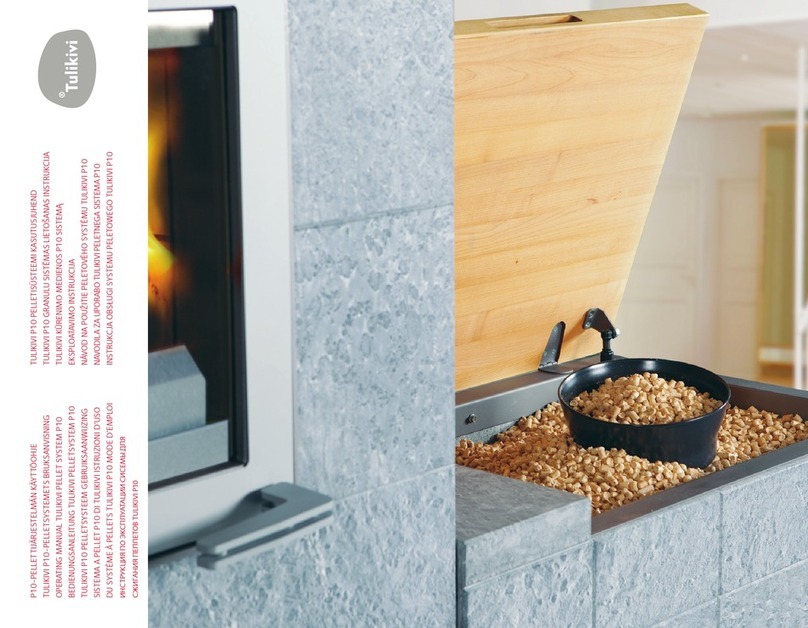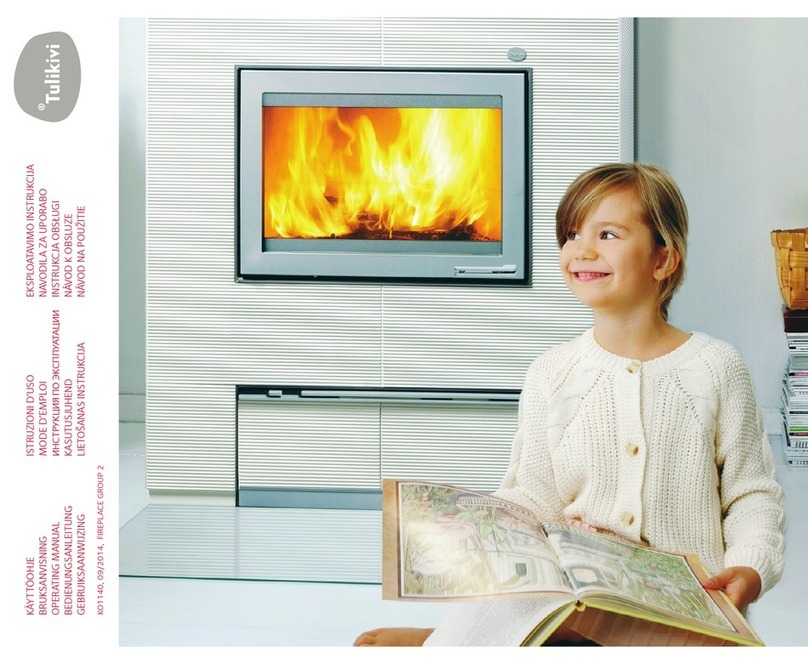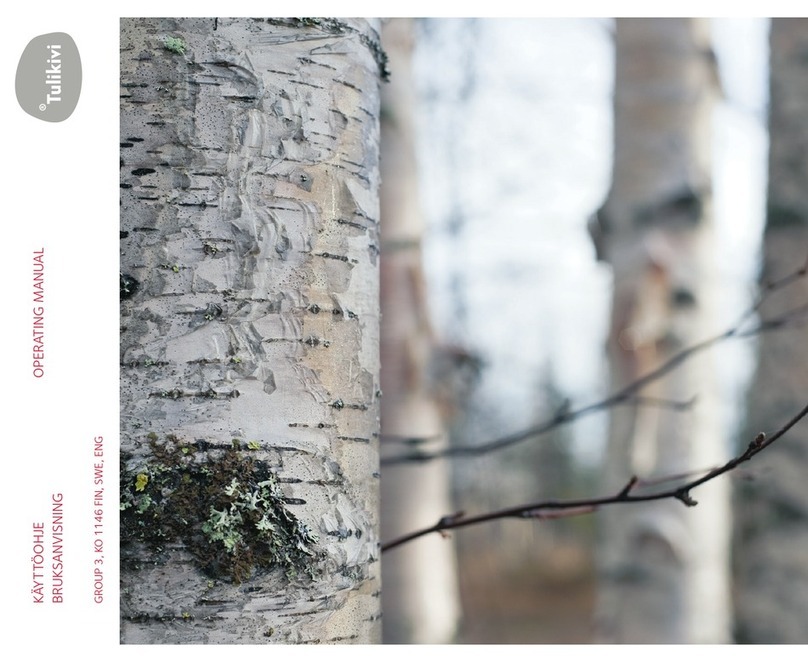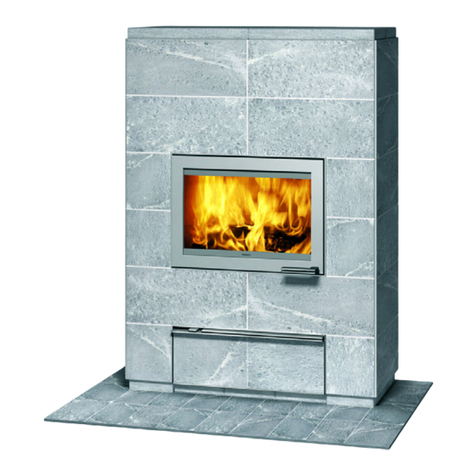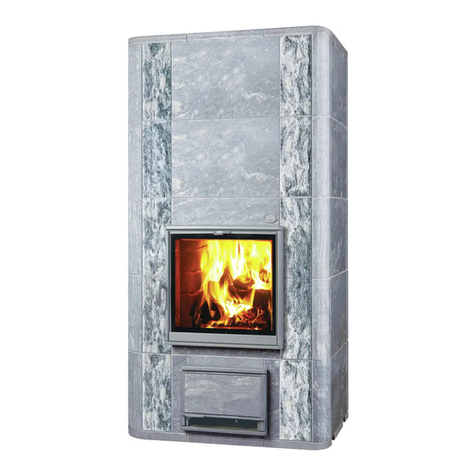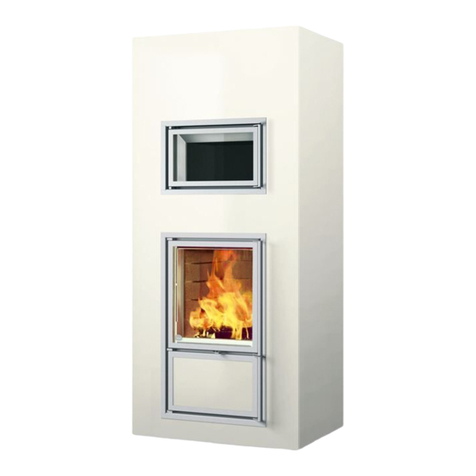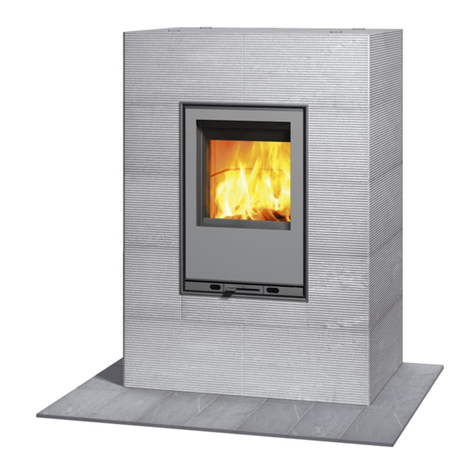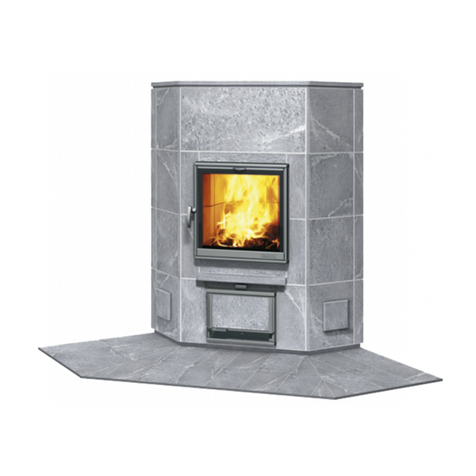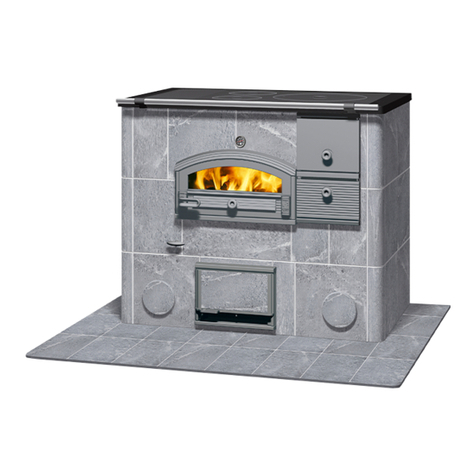
6
Normaali käyttö
ARINAN JA TUHKALAATIKON TARKASTAMINEN
Ennen sytytystä, puhdista tulipesän pohjalta ylimääräiset tuhkat
ja suurimmat hiilet esimerkiksi pehmeällä harjalla tai hiilikoukulla
tuhkalaatikkoon. Tuhkalaatikko sijaitsee arinan alla olevassa tilassa
ja siihen pääsee käsiksi arinan nostamalla. Tyhjennä tuhkalaatikko
tarvittaessa ja viimeistään, kun se on puolillaan (kuva 1). Muuten
tuhka voi päästä liian lähelle arinaa ja siten vahingoittaa sitä tai
estää riittävän palamisilman pääsyn tulipesään. Myös arina on
puhdistettava säännöllisesti, etteivät sen ilmareiät tukkeennu.
Puhdistus on helpointa suorittaa harjalla. Arinaa ja tulipesää
puhdistettaessa aseta ilmansäädin kiinni-asentoon (kuva A) ja
hormipelti (mikäli asennettu*) auki.
Tuhkalaatikon voi poistaa vain, kun takka on kylmä ja se ei ole
käytössä. Turvallisuussyistä käsittele tuhkaa ainoastaan, kun se
on jäähtynyttä ja varmista, ettei tuhkassa ole hehkuvia hiiliä,
jotka voisivat aiheuttaa tulipalon jäteastiassa. Varastoi tuhka
suljettuihin palamattomiin astioihin. Puhdasta puutuhkaa voi käyttää
puutarhakasveille lannoitteena.
Lämmityksen aikana pidä tuhkalaatikko aina paikallaan ja takan
luukku suljettuna.
PALAMISILMAN VARMISTAMINEN
Tarkasta, että hormipelti (mikäli asennettu*) on auki ja ilmansäädin
on täysin auki -asennossa (kuvat 2 ja B) 5–10 minuuttia
ennen sytytystä. Katkaise lisäksi liesituuletin ja koneellinen
ilmanvaihto ennen sytytystä. Jos ilmanvaihtokoneessa on
mahdollisuus käyttää ns. takkakytkintä tai ylipaineistusta, on
se aina suositeltavaa. Tulisijan ollessa käytössä tulee varmistaa
palamisilman riittävä saanti. Tämä on erityisen tärkeää uusissa
tiivisrakenteisissa taloissa ja silloin, kun toinenkin lämmityslaite
on käytössä samanaikaisesti. Ilmaa tarvitaan noin 8–15 m
3
yhtä
polttoainekiloa kohti.
VEDON VARMISTAMINEN
Mikäli tulisija on ollut pitkään käyttämättömänä, tarkasta hormin
veto. Purista pala paperia kevyesti palloksi, aseta se arinalle, sytytä ja
sulje tulisijan luukku (kuva 3). Jos liekki on kirkas ja pystysuuntainen,
hormissa on riittävä veto. Jos veto on huono, puhalla esim.
hiustenkuivaajalla lämmintä ilmaa tulipesän yläosaan tai hormiin sen
nuohousluukun kautta. Ole erityisen huolellinen silloin, kun käytät
takkaa kausiluonteisesti tai huonoissa veto- tai sääolosuhteissa. Kun
tulisija on ollut pidempään käyttämättä, tulee hormi ja tulipesä aina
ensin tarkastaa tukosten varalta ennen muita toimenpiteitä.
POLTETTAVA PUUMÄÄRÄ
Eri mallien polttopuun kulutus (kg/h) on esitetty sivulla 3 olevassa
teknisessätaulukossa.Takkaa tulee lämmittää taulukossamääritellyllä
puumäärällä yhtä tuntia kohti, sillä pitkäkestoinen liiallinen teho voi
vaurioittaa tulisijan rakenteita pysyvästi.
SYTYTTÄMINEN
Sytytystä varten pilko muutama polttopuu ohuiksi, noin 1–2 cm
paksuiksi pilkkeiksi. Lado sytytyspanos sen jälkeen ilmavasti ristikkäin
arinalle (kuva 4). Aseta sytyke sen alle. Tarkasta, että ilmansäädin
on edelleen täysin auki -asennossa (kuva B). Sytytä ja sulje tulisijan
luukku. Huomioi, että palavan nesteen (öljy, bensiini jne.) käyttö
sytytykseen on kielletty!
Anna sytytyspuiden palaa vapaasti pitäen ilmansäädin täysin auki
-asennossa (kuva 5). Kun sytytyspanos on syttynyt hyvin ja veto
on tarpeeksi voimakas, voit lisätä tulipesään isompia puita teknisessä
taulukossa ilmoitetun polttopuun kulutuksen (kg/h) mukaisesti.
Lisätessäsi puuta avaa luukku aina hyvin hitaasti. Näin estät savua
ja tuhkaa pääsemästä huonetilaan. Anna puiden syttyä rauhassa
pitäen ilmansäädin edelleen täysin auki -asennossa (kuva 6).
Kun panos on syttynyt hyvin, pienennä palamisilman määrää
ilmansäädintä käyttäen (kuva 7) saavuttaaksesi takallesi teknisessä
taulukossa määritellyn palamisnopeuden (kg/h).
Palamistehoa säädellään ilmansäätimen avulla. Liian tehokas
palaminen, johon liittyy voimakas veto, sekä ohjeistettua suurempi
polttopuun määrä voivat aiheuttaa ylikuumenemista ja vahingoittaa
sekä tulisijaa että hormia. Liian heikko palaminen puolestaan johtaa
siihen, että luukun lasi nokeentuu tai luukkua avatessa ja puita
lisätessä huonetilaan pääsee savua.
Tulisijan luukku on käytön aikana pidettävä pääsääntöisesti
suljettuna. Poikkeuksena ovat tässä ohjeessa esitetyt ensimmäinen
lämmityskerta, tulisijan sytytys, puun lisäys ja hiilloksen kohennus
palamisen loppuvaiheessa.
Lämmityksen aikana ja sen jälkeenkin tulisija ja sen osat
ovat kuumia. Palovammavaaran vuoksi kosketa vain kahvaa ja
ilmansäädintä kuumuutta kestävää hanskaa apuna käyttäen.
Ole huolellinen käyttäessäsi kiertoilmatakkaa. Tulisijaa ei saa jättää
ilman valvontaa, vaan sen toimintaa on seurattava koko lämmityksen
ajan. Kun takan metallinen sisärunko lämpenee tai jäähtyy, lähtee siitä
tiettyjä ääniä, jotka liittyvät normaaliin lämpölaajenemiseen.
PUIDEN LISÄÄMINEN
Puita voidaan lisätä, kun edellinen panos on palanut hiillokselle
ja viimeisetkin liekit ovat hävinneet. Estääksesi savua ja tuhkaa
pääsemästä huoneeseen puiden lisäämisen yhteydessä, siirrä
ilmansäädin täysin auki -asentoon (kuva B) noin 5–10 sekuntia
ennen tulisijan luukun avaamista. Avaa luukku sitten hieman raolleen
ja odota muutama sekunti, että hormi imaisee savut (kuva 8), ja
avaa luukku kokonaan vasta sitten. Kun avaat luukun, ole erityisen
varovainen, ettei kuumaa hiillosta pääse putoamaan tulipesästä.
Lisättyäsi puut sulje luukku. Puita lisätessä on hyvä käyttää myös
ilmanvaihdon hetkellistä ylipaineistusta, jos tähän on mahdollisuus.
Pidä ilmansäädin täysin auki -asennossa, kunnes lisäpanos on
syttynyt niin hyvin, että se palaa kirkkaalla liekillä (kuva 9). Pienennä
palamisilman määrää tämän jälkeen palauttamalla ilmansäädin
alkuperäiselle paikalleen.
Jatka lämmitystä tarpeesi mukaan kohdan ”Puiden lisääminen”
ohjetta toistaen. Muista, että lisätyn puumäärän tulisi aina vastata
takan todellista tuntikulutusarvoa (katso tekninen taulukko/
polttopuun kulutus).
Älä ylilämmitä tulisijaasi. Huomioi, että kiertoilmatakkaa ei ole
valmistettu tuottamaan jatkuvaa lämpöä, vaan toimimaan lämmitys
ajoittain keskeyttäen pääasiassa siksi, että tuhkalaatikko täytyy
tyhjentää sen jälkeen, kun tuhka on täysin jäähtynyt.
LÄMMITYKSEN LOPETTAMINEN
Kun viimeinen panos on palanut hiillosvaiheeseen, siirrä ilmansäädin
täysin auki -asentoon (kuvat 10 ja B). Vedä sen jälkeen sopivalla
työkalulla tulipesän reunoilla oleva hiillos arinan päälle. Kohenna
hiillosta pari kertaa, kunnes se on palanut loppuun. Tämän jälkeen
siirrä ilmansäädin kiinni-asentoon ja sulje hormipelti (mikäli
asennettu*; kuvat A ja 11). Jos palamisilma johdetaan suoraan
ulkoa tulisijaan, on tärkeää pitää ilmansäädin kiinni aina lämmitys-
kertojen välillä, jottei tulisija jäähdy turhaan.
Älä sulje hormipeltiä (mikäli asennettu*) ja siirrä ilmansäädintä
kiinni-asentoon liian aikaisin, koska silloin saattaa muodostua
vaarallista häkäkaasua. Muista! Häkä on hajuton, mauton, väritön ja
myrkyllinen kaasu, joten ole huolellinen.
